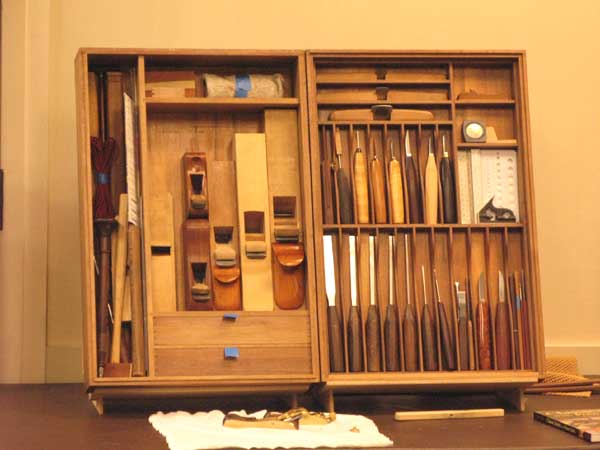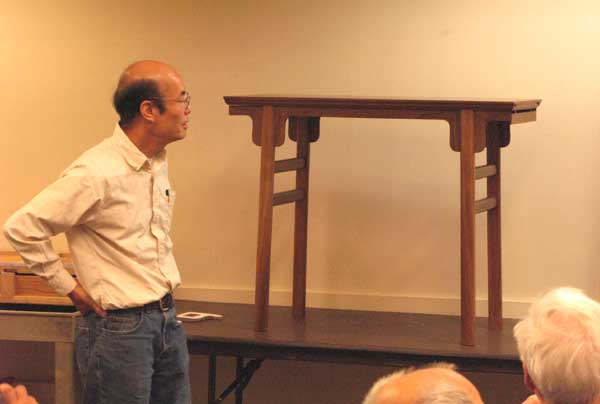
Last meeting
![]()
Announcements:
On September 28/29 BAWA will have a booth at the Woodcraft Faire in San Carlos. Volunteers are needed to staff the booth. Please use the sign-up sheet. Open slots to staff are as follows: Fri 11am to 3pm and 3pm to 6pm, Saturday 11am to 1pm and 3pm to 6pm.
On October 6, BAWA will have a booth at the Saw Dust shop in Sunnyvale. A sign up sheet is available for volunteers. Contact Bill Henzel at wjhenzel1@aol.com or 408-254-1175 to sign up for either or both events.
Yeung Chan will hold a seminar on Classic Joints for Power Tools at Per Madsen's shop on November 3 &4. The cost is $150. Please send your checks, made out to Per Madsen, to Per Madsen PO Box 330101, San Francisco CA 94133 no later than September 22. You can contact Per at permads@comcast.net or 415-928-4509.
Dan Goodman gave us a review of the Encyclopedia of Furniture Making. The book, he said, gives the reader a broad perspective of woodworking, from felling the tree to finishing your project. It touches on many subjects, none in too much depth. This book is a good place to start if you are looking for information.
Bill Henzel recently returned from an extended western expedition from Glacier Park in the Rockies to Banff and Jasper in Canada. He was struck by the vast number of dying conifer trees. The rangers explained that the pine bore beetle and fungus have become more virulent because of climate change. In these damaged forest areas, deciduous trees are likely to replace the conifers. He encouraged us to become concerned about climate change. He tells us more about his concerns in the President's Corner this month.
The September BAWA meeting will be held at Joseph Brown Distinctive Woodworking in San Carlos. Neil White will be our program speaker at the October meeting. The November meeting will feature the annual box contest. Gentlemen and ladies --- start your boxes. The December meeting will be the Pot Luck Dessert. We need a volunteer to coordinate this event. Please contact Bill Henzel.
Arnold Champagne said that the College of the Redwoods will be having a show at the Highlight Gallery in Mendocino from September 8 to October. All graduates of the program have been asked to contribute pieces. Arnie is making an octagonal display case.
Stan Booker announced the raffle prize: two pieces of 5/4 maple, 12" wide, 8 feet long.
Door prizes for the evening included a gift certificate for Japan Woodworker, a push stick, and a diamond hone. BAWA t-shirts are available for purchase.
Show & Tell:
Frank Ramsey visited the AWFS 50th Anniversary Annual Convention in Las Vegas, July 16 to 21. The show was enormous, covering three halls with over 500,000 square feet of exhibit space, and more than 900 exhibitors. Included among the participants were:
- Turned cowboy hats, less than 1/16" thick. A red light is used during turning to gauge proper thickness
- Steel City Tools, now offering table saws, band saws, sanders etc
- Birch soccer balls for $40
- CAD software for designing kitchens and cabinets
- An electronic miter bevel called Pro Miter for $400
- Many dovetail drawer manufacturers
- Grizzley Tools had an immense island display area
- Valspar offered recipe cards for various finishing techniques and materials
- Laser cutting and engraving systems, and
- TV lifts
Frank professed to having been so busy at the show that he found no time to visit the casinos. Sure, we believe you, Frank.
Yeung Chan brought in a new walnut tool box he uses while traveling the country, giving his seminar on Classic Joints. The original box had been damaged during transit on UPS, mostly because its frame and panel construction did not was not strong enough to withstand jostling during transport.
The new box, measuring approximately 18 inches, 30 inches long and 6 inches deep, has dovetail joints at all four corners. The top and bottom are walnut veneer on 3/16th plywood. A lace wood strip edges the top of the box. The interior dividing partitions are joined to the sides of the box with sliding dovetail joints. A spline joins the partitions to the bottom panel.
Next Yeung showed us a 25 degree low angle in-fill plane he had just made using bronze. The throat of the plane is set at mid-sole to improve stability when starting to cut. There is no moveable frog because Yeung does not feel it is necessary. He places the blade bevel down to improve the cutting angle.

Main Speaker:
In 2002 Yeung Chan published his book Classic Joints with Power Tools. Since then, Yeung has given seminars, taught classes and made many presentations on this subject. Tonight, we were honored to see how these joints could be used to construct a table.
The purpose of machine made joints, Yeung explained, is to make the joints quicker while maintaining the same or even higher quality standards. The joints were 95% made with power tools: a table saw, a mortiser router and band saw.
The table top is a large panel made up of three tongue and groove boards. The tongue and grooves were created on the table saw, but could also be done with a router. The disadvantage of using the router is that it is difficult to control the chatter created by the accumulation of chips between the cutter bit and the board.
The joined panel of the top, however, needs reinforcing. Yeung adds perpendicular bottom rails. A dovetail on the rail slides into a mating dovetail groove on the bottom of the tabletop panel. The dovetail on the rail is tapered slightly to facilitate insertion of the rail. He creates the taper by shimming one end of the rail against the router fence while running it past the dovetail router bit. The ends of the rails are fashioned into tenons that will fit into the frame of the tabletop.

The tabletop frame is made with mitered mortise and tenon joints. Mortises are cut into the sides and ends of the frame pieces to accept the tenons of the top rails. The mortises are cut just above center on the top frame because the underside of the frame is tapered.
Each of the two leg sets are made in an H configuration using mortise and tenon joints. Opposing H's are joined with an apron that also inserts into the top of the H leg set. The leg sets are topped with tenons that fit into mortises cut into the frame of the table top. The apron ends are joined with hook miter joints.
The table is finished with oil and shellac. Yeung's goal is to fill the wood pores, minimizing potential wood movement.
Yeung estimated that it took him three days to make this table. The salient message is the quality comes before speed. So begin your project with quality as your goal. Speed will come.
John Blackmore & Mark Rand